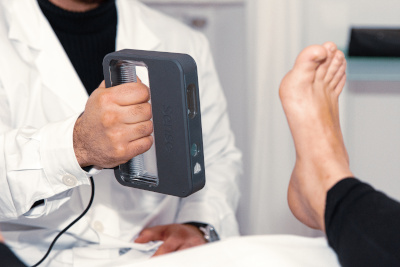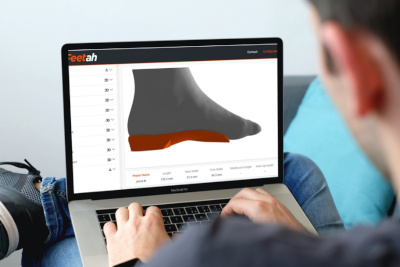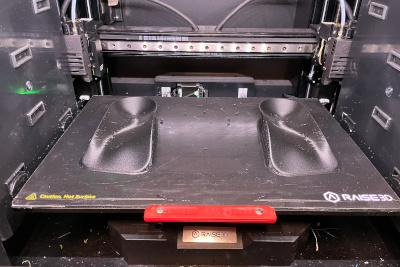Try it for 15 daysUse the old version
Feetah - 3D foot orthosis
The innovative process for the creation of the foot orthosis
Biomechanical functional insoles
You can create functional orthopedic insoles that will allow you to improve the structure of the foot, improving the gait and dynamic function of your patients.
Using the most modern concepts of biomechanics with 3D printing, these innovative orthoses will allow you to better rehabilitate your dysfunctions, and patients quickly resolve painful symptoms.
Accommodative insoles multilayer and density variable
Accommodative insoles improve foot comfort through better load distribution. Thanks to these orthoses you can also intervene in a compensatory and palliative way. The possibility of using multi-materials and creating zones with variable density allows overloads to be reduced, eliminating pain, the risk of falling and the risk of injuries. Thanks to the variable density, obtainable only with the Additive 3D Foot Technology, you can obtain orthoses with limited thicknesses usable in any shoe with a considerable capacity to reduce plantar overloads in identified areas.
Online design software
The first 3D foot orthotic design software born from the experience of professionals and university research aimed at healthcare professionals or those dealing with foot orthotic therapy.
No IT experience is needed: thanks to years of development, Feetah allows you to design all the modifications and geometries for your insoles quickly, simply and intuitively.
Simple, complete, fast
The orthotic insole design process is guided step by step and does not require specific 3D modeling skills from the Podiatrist. It is easy to design functional orthoses and accommodating insoles, it only takes a couple of minutes!
Furthermore, thanks to the cloud system, archived projects can be reopened to make changes later.
Great attention to detail, customization, precision, extreme durability, eco-sustainable materials and last but not least... quality! all this is FEETAH!
To sum up
- Open to any type of 3D scanner/3D printer
- Economical (Pay-as-you-go solution)
- Simple and intuitive
- Scientifically validated and developed based on the direct needs of professionals in the field of podiatry and orthopedics
- Capable of producing insoles with multiple materials (POLYPROPYLENE - NYLON CARBON - PPCF - PLA - ABS - PETG -TPU - TPS)
Green solution
Reduces waste of materials
Use of renewable and recycled materials (such as recycled ppcf) for the production of eco-sustainable insoles.
Lower co2 emitted into the air compared to the use of plaster and manual technique using materials renewable and recycled
The method

3D scan of the patient's foot
At the beginning it’s necessary to scan the plantar surface of the foot using a 3D scanner in order to obtain an OBJ file.
Recently many 3D scanners and free Apps have been developed to improve the production of custom foot orthoses, minimize plaster storage requirements and enable exact duplication of a prescription.
We can help you to explore the best scanner or scanning app based on your investment possibilities.

3D modeling of the foot orthosis
Feetah is the most advanced, complete and easy to use 3D configurator for Custom Foot Orthotic applications.
The input data was the mesh of the scanned foot and three reference points, corresponding to the first and the fifth metatarsophalangeal joints and to the center of the calcaneus.
The workflow in Feetah results intuitive and allows easy and interactive customization of the foot orthosis as reported by users without any CAD skills.

3D printing of the foot orthosis
As a last step there is the 3D printing of the orthosis, you can use your 3D printer or in alternative we can help you to explore the best 3D printer based on your investment possibilities.
Our aim is to put powerful and accurate 3D printed custom orthotic insole in the hands of all practitioners so we also offer a 3D printing service.
FAQ
Custom 3D printed orthotic insoles offer several advantages over standard orthotic insoles:
- COMFORT: Custom orthopedic insoles are custom-made respecting the various morphologies of the foot, ensuring superior comfort compared to standard orthoses and improving the patient's position;
- ADHERENCE: Custom orthotic insoles are manufactured to perfectly fit the patient's foot, ensuring greater stability and safety, while a standard insole will have little chance of being appropriate to the patient's needs;
- REPRODUCIBILITY: 3D printed orthopedic insoles allow the Podiatrist to reproduce the same personalized orthosis for the same client quickly and easily, with low margins of error and allowing great attention to detail, even the smallest.
- DURABILITY: Custom orthotic insoles are made to last longer than standard orthotic insoles as they are made to withstand intensive use as they are designed with thicknesses and shapes consistent with the patient's weight and use;
- SUPPORT: Custom orthotic insoles provide specific support for the areas of the foot that need it, helping to prevent injuries and improve posture; In summary, custom orthopedic insoles offer a more effective, comfortable and durable solution than standard orthotics, guaranteeing personalized therapy and specific support for the patient.
Insoles printed using 3D technology allow high-quality orthopedic insoles to be produced, offering a series of advantages such as: reproducibility of the insole, greater precision in complex details, less waste of materials and, above all, more time to dedicate to patients.
Insoles printed using 3D additive technology are exceptional and very resistant products.
Rigid materials such as polypropylene with added carbon (PPCF) can be used to create biomechanical orthoses or flexible materials such as variable density rubbers (TPU/TPS) can be used to create accommodative orthoses.
To make templates with our solution, just follow 3 simple steps:
- Scan the patient's foot with a 3D scanner. You can choose whether to scan with the foot in an unloaded position (neutral position) or in a loaded position to verify the incidence of plantar pressures, depending on your needs and experience in the production of foot orthoses. Obviously different types of scanners can be used, from the most expensive to the cheapest as applications for mobile phones.
- Simply upload the OBJ file to our web portal and start creating the client's personalized foot orthosis using our simple web interface, depending on the need to make corrections to the patient's foot. It is also possible to use the web version from your phone or tablet.
- Once you have downloaded the .STL file from our site, you can send it to your 3D printer if you have one or, if not, you can send it to one of our 3D production centers and have it printed directly to your practice.
Feetah is an innovative online 3D modeling tool for designing orthotic insoles personalized and has the following features:
- SIMPLE AND INTUITIVE: The orthotic insole design process is guided step by step step by step and does not require specific 3D modeling skills from the user;
- COMPLETE AND FLEXIBLE: the system allows you to create functional orthoses and accommodating insoles with the possibility of obtaining very complex shapes and making all major planned changes to these devices;
- FAST: the complete design of a custom orthotic insole takes only a few minutes, leaving the possibility of reopening archived projects to make small changes to the orthotic insole even later;
- OPEN: the system allows you to import the 3D scan of the patient's foot in OBJ that can be obtained with different devices and generate the STL file of the designed orthosis to download to print yourself or to send directly to a 3D printing service;
- ONLINE: the system works in the cloud, does not require installation on a PC and an internet connection is enough to log in to your private area and start planning from any location or device;
- UPDATED: the developed solution allows you to always work with the most up-to-date version of the 3D modeling tool and have access to all new features that are gradually added;
- CHEAP: after purchasing the single license, the system provides for the possibility of monthly and annual subscriptions or the purchase of credit packages that will be used as necessary to provide the most appropriate solution to the users' needs.
3D made orthotic insoles can be used to treat many foot conditions, including:
- FLAT FOOT: the orthopedic insole can help reduce pain by improving the position of the foot and ensuring more stability and balance useful for correct movement;
- HALL FOOT: Orthopedic insoles can help distribute body weight evenly on the foot by providing a better distribution of plantar pressures avoiding areas of overload;
- PLANTAR FASCIITIS: Foot orthotics can help reduce pain related to plantar fasciitis that often occurs in patients with abnormal pronation or supination of the foot;
- MORTON'S NEUROMA: plantar orthosis can reduce pain related to compression of the interdigital nerves thanks to better positioning of the joint structures;
- METATARSALGIA: Orthotic insoles can help reduce pressure on the forefoot by redistributing the load and relieving pain;
- ARTHRITIS: the plantar orthosis can help patients who suffer from foot pain related to rheumatic pathologies;
- TENDONITIS: Orthotic insoles can help reduce painful tendinopathies by controlling abnormal and pathological movement;
- SPORTS INJURIES: Orthotic insoles can provide additional support and cushioning to reduce risk of injury and improve performance;
It is important to consult a podiatrist or orthopedic surgeon to determine if an orthotic insole is for you. Suitable for your specific pathology and to obtain a personalized prescription.
3D printing of the insole aims to overcome the critical problems of the traditional process while maintaining the quality of the orthosis created.
The current practice of orthosis production is based entirely on manual activities, which are not very reproducible, which depend on the skills of each operator and which occupy the professional for many hours.
Additive manufacturing, on the other hand, is a process of joining materials to create objects from 3D models, typically layer by layer, unlike subtractive manufacturing technologies.
An advantage over subtractive processes (CAD-CAM) is the possibility of creating very complex structures with different internal densities and very thin thicknesses to obtain more or less rigid orthoses without changing the thickness. For this phase of the process we have selected 3D printing materials and systems, with the best quality-price ratio, capable of guaranteeing the quality of the finished products. The suggested 3D printers have been specially customized and tested to create orthotic insoles using the Feetah system.


 Español
Español  Italiano
Italiano 